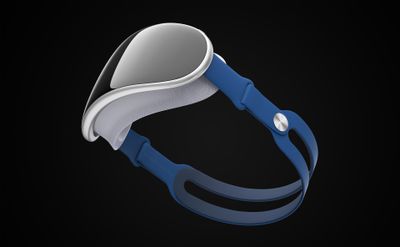According to The Information, Apple's mixed-reality headset will have a physical dial, a waist-mounted battery pack, and small motors to adjust its lens.
 Concept render based on purported leaked information by Ian Zelbo
Concept render based on purported leaked information by Ian ZelboA paywalled report claims to show a wide range of previously unseen features for the headset.
- A waist-mounted battery, connected via a magnetic, MagSafe-like power cable to the headset's headband. One battery charge lasts no longer than two hours, but users can swap the battery out for longer sessions.
- A design that uses aluminum, glass, and carbon fiber to reduce its size and weight. Cameras are largely concealed for aesthetic reasons.
- A small, Digital Crown-like dial on its right side that enables users to quickly transition between the virtual and physical world. Unlike the Apple Watch, it will not offer haptic feedback.
- Apple has developed different headbands, including one for consumers made of a similar material to Apple Watch sport bands with built-in speakers, and one targeted at developers.
- Magnetically attachable custom prescription lenses for glasses-wearers.
- Small motors to automatically adjust its internal lenses to match the wearer's interpupillary distance, providing the largest field of view possible for each individual.
- A 120-degree field of view, like the Valve Index – more than the Meta Quest Pro's 106-degree field of view.
- The H2 chip for ultra-low latency connection with the second-generation AirPods Pro and future AirPods models.
- Two chips, including a main SoC, including a CPU, GPU, and memory, and a dedicated image signal processor. Both are fabricated with a 5nm process, meaning that the headset misses out on advancements expected to come to other Apple chips later this year. The chips communicate via a custom streaming codec that Apple was forced to develop due to unacceptable latency.
- The dedicated ISP translates the distorted images captured by the external cameras into a faithful video representation of the user's surroundings with low latency. The chip contains custom high-bandwidth memory made by SK Hynix.
- The ability to run existing iOS apps in 2D.
There is no 3.5mm jack on the device and third-party headphones don't work well with the headset. Recent and future AirPods models have been designed to work with low-latency headsets. The H2 chip is said to offer an "ultra-low-latency" mode when used with the second-gen AirPods Pro. Apple has debated whether it's a good idea to make AirPods mandatory for communication on the headset.
Before Apple integrated the battery into the headband of the Meta Quest Pro, the headset used large external batteries for power tools. Sir Jony Ive, Apple's former design chief, advocated for the return of a battery pack to the power source.
Engineers faced technical challenges with the headband acting as a conduit for power to the headset, so that is no longer the case.
It is said that Apple favors hand- tracking and voice recognition to control the headset, but it has tested other ways to do so.
Apple is not expected to focus much on gaming for the device, and the headset is not expected to be accompanied by a controller. The company has a plan to allow Unity to be its first partner to offer full virtual reality experiences in the headset.
There is a high level of accuracy when mimicking a user's facial expressions and body movements. It has created software that allows users to perform activities like dragging the Maps app off a Mac screen and using it to display a 3D model of a city on a table top, and has devoted resources to educational resources for the device.
Several features it previously revealed and independently confirmed were also included in the information.
- The headset has a large outward-facing display on its front. This can show the facial expressions of the headset's wearer to people around them, seeking to reduce a sense of isolation when using the device.
- The outward-facing display features an ultra-low refresh rate and reduced power consumption, much like the always-on display of the Apple Watch and iPhone 14 Pro.
- Interior Micro OLED displays for each eye with a 4K resolution, made by Sony, forming an 8K image overall.
- Each eye is tracked by at least one camera, allowing the headset to accurately show the user's gaze on an avatar. Eye-tracking also enables the headset to perform foveated rendering to conserve power by only rendering imagery in full resolution directly where the user is looking.
- More than a dozen cameras and sensors capture both facial expressions and body movements, including the user's legs. Apple apparently removed cameras to capture eyebrow and jaw movements when it developed machine learning to accomplish this.
- Both short- and long-range LiDAR scanners to map surfaces and distances in three dimensions.
According to the report, Apple supplier Pegatron assembled thousands of prototype units of the headset last year at a facility near Shanghai. The device was supposed to be launched in 2020.
According to four people with knowledge of the matter, Apple has talked about pricing the headset at $3,000 or more depending on its configuration.
 Concept render based on purported leaked information by Ian Zelbo
Concept render based on purported leaked information by Ian Zelbo